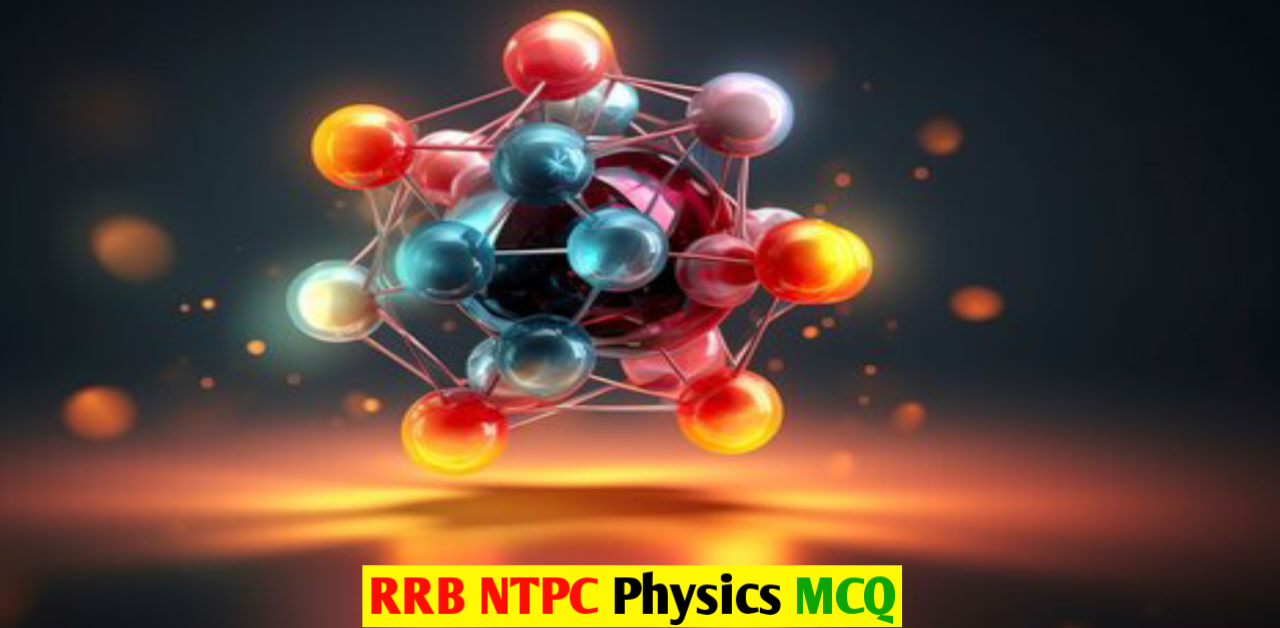In this article you will be provided 50 most important MCQ questions of physics for RRB NTPC CBT 2. The questions are based on previous year questions of RRB NTPC CBT 2. Here you will get 12 questions with detailed explanation. Remaining questions will be provided in PDF format at the end of this article.
RRB NTPC CBT 2 exam MCQ questions:
•1. What causes the phenomenon of diffraction?
a) Reflection of light
b) Bending of light around obstacles
c) Scattering of light
d) Absorption of light
•Answer•: b) Bending of light around obstacles
•Explanation•: Diffraction occurs when a wave bends around the edges of an obstacle or passes through an opening, spreading out as a result.
•2. Which particle is exchanged during the electromagnetic interaction?•
a) Photon
b) Neutron
c) Electron
d) Proton
•Answer•: a) Photon
•Explanation•: Photons are the force carriers for the electromagnetic interaction, transmitting energy between charged particles.
•3. What is the source of Earth’s magnetic field?•
a) Solar wind
b) Earth’s molten iron core
c) Gravity
d) Tectonic activity
•Answer•: b) Earth’s molten iron core
•Explanation•: Earth’s magnetic field is generated by the movement of molten iron in the outer core, which creates electric currents.
•4. What is the main cause of ocean tides on Earth?•
a) Wind
b) The Moon’s gravitational pull
c) Earth’s rotation
d) Earth’s magnetic field
•Answer•: b) The Moon’s gravitational pull
•Explanation•: Ocean tides are primarily caused by the gravitational forces exerted by the Moon, with additional influence from the Sun.
•5. What is the primary factor that affects the buoyancy of an object?•
a) Object’s color
b) Object’s mass
c) Object’s density relative to the fluid
d) Object’s temperature
•Answer•: c) Object’s density relative to the fluid
•Explanation•: Buoyancy depends on the object’s density compared to the fluid. Objects less dense than the fluid will float, while denser ones sink.
•6. What property of a material is responsible for its resistance to being stretched or compressed?•
a) Elasticity
b) Conductivity
c) Malleability
d) Plasticity
•Answer•: a) Elasticity
•Explanation•: Elasticity is the property of a material that allows it to return to its original shape after being stretched or compressed.
•7. What is the function of a diode in an electrical circuit?•
a) Store energy
b) Allow current in one direction
c) Increase voltage
d) Measure current
•Answer•: b) Allow current in one direction
•Explanation•: A diode allows current to flow in only one direction, preventing reverse flow and protecting components in a circuit.
•8. What happens to light when it enters a material with a higher refractive index?•
a) It slows down
b) It speeds up
c) It changes color
d) It scatters
•Answer•: a) It slows down
•Explanation•: Light slows down when it enters a material with a higher refractive index due to the denser medium affecting its speed.
•9. Why do astronauts experience bone loss in space?
a) Lack of exercise
b) Low gravity environment
c) Low oxygen levels
d) High radiation exposure
•Answer•: b) Low gravity environment
•Explanation•: In microgravity, bones experience less stress, which leads to bone density loss due to reduced mechanical loading.
•10. What is the role of a resistor in an electrical circuit?•
a) Increase current
b) Reduce voltage
c) Limit current
d) Store charge
•Answer•: c) Limit current
•Explanation•: A resistor limits the amount of current flowing through a circuit by providing resistance, preventing overheating and damage.
•11. What happens to the wavelength of sound as it moves from air into water?•
a) It decreases
b) It increases
c) It remains the same
d) It is absorbed
•Answer•: b) It increases
•Explanation•: Sound travels faster in water than in air, which increases its wavelength while the frequency remains constant.
•12. Which of the following phenomena supports the particle nature of light?•
a) Diffraction
b) Interference
c) Photoelectric effect
d) Refraction
•Answer•: c) Photoelectric effect
•Explanation•: The photoelectric effect demonstrates that light consists of particles (photons) as it can eject electrons from a metal surface.
To download the PDF of the remaining questions of RRB NTPC CBT 2 pattern
Read more MCQ questions for RRB NTPC CBT 2 on our Website Masteryourgk.in
To attempt free mock test
You can also visit Testbook.com for online classes for RRB NTPC CBT 2.

